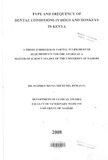| dc.description.abstract | This study aimed to determine the prevalence, clinical features and interventions for
dental conditions affecting dogs and donkeys. Two hundred and thirty five dogs from the
University of Nairobi, Small Animal Clinic were used. Dental history was taken, physical
and dental examination done and the findings recorded in Modified Triadan charts.
Dental conditions were classified into three categories; periodontal, endodontic and
miscellaneous.
Dental radiology was also performed in twelve dogs with periodontal disease and oral
tumors, under general anaesthesia, using conventional mobile x-ray equipment. Dental
radiographs were obtained with 55kV, lOmAs and a focal length of 40 cm. The technique
was used to assess the alveolar crestal bone, the periodontal ligament, the lamina dura,
periapical radiolucency, tooth roots, and other non-odontogenic changes. Dental
intervention procedures were then carried out in selected dogs using manual dental
instruments and soft tissue surgery techniques.
One thousand, two hundred and eleven donkeys from the KSPCA clinics in Nairobi,
Limuru, Kiambu, Bomet, Nyahururu, Maai-Mahiu, Nanyuki, Mweiga and Rumuruti were
used in the study. Dental history and findings on physical and dental examination were
recorded in Modified Triadan charts. Clinical examination and treatment interventions
were done under manual restraint.
xvi
Sixty-eightdogs had various dental conditions, indicating a prevalence rate of28.9%.
Of these cases, the most frequently observed periodontal conditions were; dental plaque
(89.7%), gingivitis (76.5%), halitosis (69.1%), and dental calculi (64.7%). Periodontitis
(35.1%), gingival recession (25.0%), periodontal pockets (23.5%), and mobile teeth
(16.2%), were less frequently observed. The most common endodontic conditions were
pulp exposures (32.4%), fractured teeth (20.6%), and dental caries (19.1%) some of
which showed radiographic changes (17.6%). Missing teeth due to periodontal disease or
lack of eruption (7.4%), and dental fistulas (2.9%) occurred infrequently. Miscellaneous
teeth conditions were malaligned teeth (7.4%), retained deciduous teeth (5.9%), and
supernumerary teeth (1.5%). Other signs associated with dental conditions included;
regional lymphadenopathy (8.8%), soft tissue trauma (5.9%), brachygnathism (5.9%),
alterations in extra oral structures, such as asymmetry (5.9%), oral tumors (2.9%), and
glossitis (2.9%). Radiographic diagnoses were made for teeth fractures, periodontal
disease, dental abscesses and oral tumors. Dental procedures performed in the dog
included; dental scaling, manual polishing, subgingival curettage (root planing), and
extractions. Soft tissue surgery involved gingivectomy, restorative cheiloplasty and
antidrool cheiloplasty. Oral antisepsis and systemic antibiotic treatment were used
adjunctively.
One hundred and forty nine donkeys representing a prevalence of 12.3% had various
dental conditions. The most frequently observed dental conditions were wave mouth
(18.8%), dental calculi (12.9%), enamel caps (11.8%) and incisor conditions (9.4%)
such as retained (persistent) deciduous incisors, abnormal eruption, excessive wear, and
fractures. Conditions that occurred in moderate frequency included sharp enamel edges
XVll
(8.8%), dental calculi with gingivitis (8.2%), step mouth (7.1 %) and hooks on premolars
(7.1%). The least frequent dental conditions were loose teeth (4.7%), discolored teeth
(4.7%), swelling on mandible (1.8%), necrotising stomatitis (1.8%), gingival
hyperplasia (1.2%), traumatic cheilitis (1.2%) and maxillary swelling (0.6%). Dental
rasping was carried out to correct conditions due to abnormal wear such as wave mouth
and sharp enamel edges. Extraction was carried out for enamel caps, loose teeth, and
shedding incisors. Oral sanitization was done for cases with necrotising stomatitis and
traumatic cheilitis.
This study has documented the prevalence, clinical features and interventions for dental
conditions in dogs and donkeys. The data is useful in highlighting the nature and
frequency of dental conditions encountered in these species. Conventional x-ray
equipment was also adapted successfully for dental radiology and proved an invaluable
aid in diagnosis of endodontic conditions in dogs. Successful intervention techniques for
dental conditions in the two species were also performed. The application of the findings
of this study by veterinarians, animal scientists and owners should enhance the health and
welfare status of these animals in Kenya. | en |

